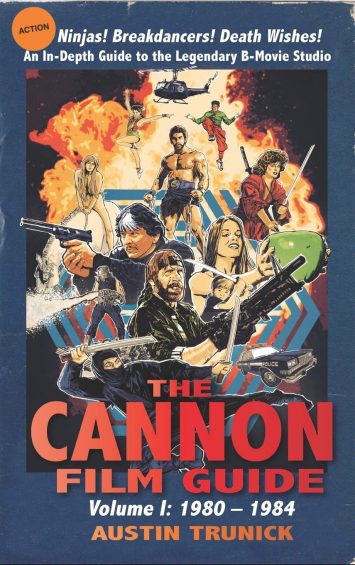 By AUSTIN TRUNICK (BearManor Media; 2020)
By AUSTIN TRUNICK (BearManor Media; 2020)
This hefty 527 page book is either a standout example of gonzo scholarship or an extended manifestation of unfiltered insanity. Either way I’m glad the book exists, as it’s as gloriously obsessive a study of the late, notorious Cannon Films as any eighties movie buff could possibly desire. If you happen to fall into that group I think it’s pretty obvious that THE CANNON FILM GUIDE Volume 1 is required reading, period.
…required reading, period.
Cannon was an exploitation movie outfit purchased by the Israeli cousins Menahem Golan and Yoram Globus in 1979. Golan-Globus went on to turn Cannon into a mini-powerhouse that boldly intermixed trash and prestige, with lowbrow fare like REVENGE OF THE NINJA and INVASION U.S.A. co-existing with the more upscale likes of RUNAWAY TRAIN and DUET FOR ONE. This book, the first of a three volume whole, only covers the early years of Cannon’s output, which was heavy on the trash part of the equation.
All of Cannon’s major releases from the years 1980-84 are profiled in these pages. Included are well-known hits like ENTER THE NINJA, DEATH WISH II, BREAKIN’ and MISSING IN ACTION, as well as more obscure entries like TEEN MOTHERS, NANA and THE SECRET OF YOLANDA. Each has a detailed backstory and production history, laid out by author Austin Trunick in a voluminously researched and reader-friendly manner that’s not without a great deal of humor; truthfully there’s no way to discuss Cannon’s output without making fun of at least some of it, and Trunick has undoubtedly seen more trashy Cannon movies than any sane person could possibly handle. Concise and revealing interviews with participants in the films discussed, such as actress Diane Franklin (from THE LAST AMERICAN VIRGIN), director Luigi Cozzi (of HERCULES) and screenwriter James Brunner (of MISSING IN ACTION), make for welcome inclusions.
One especially noteworthy aspect of this book is that, while it fully takes into account the many missteps made by Messrs. Golan and Globus, its overall attitude is unerringly positive and enthusiastic. That’s directly opposed to the view espoused by the other major Cannon book, HOLLYWOOD A GO-GO by Andrew Yule, which was published in 1987 (i.e. while Cannon was still in business) and took a resolutely negative, sky-is-falling stance. Back then you wouldn’t have found much argument with that view, as Cannon was widely viewed as (at best) a laughingstock. This book, then, stands as something of a monument to how public attitudes toward Cannon, and 1980s exploitation cinema overall, have shifted.
…while it fully takes into account the many missteps made by Messrs. Golan and Globus, its overall attitude is unerringly positive and enthusiastic.
I for one am glad the shift has occurred, as Cannon had plenty to offer in terms of “quality.” That’s something this book demonstrates quite memorably in its frank but affectionate reflections on Cannon mess-terpieces like THE APPLE (the world’s first and only Biblically-infused, disco-fied futuristic musical), BREAKIN’ 2: ELECTRIC BOOGALOO (which fully lives up to that sublimely nutty title) and NINJA III: THE DOMINATION (think KILL BILL meets THE EXORCIST). “Good” those movie aren’t, but they do fully back up Trunick’s claim that “While it’s rare to find a critically acclaimed film bearing the company’s famous arrow logo, it’s even more difficult to find a Cannon movie that isn’t thoroughly entertaining from its title screen to its final credits roll.”
This book is good enough that despite the not-inconsiderable page length it left me wanting more. Luckily there is indeed more with THE CANNON FILM GUIDE Volume II exploring Cannon’s release slate from 1985 onward (when the aforementioned RUNAWAY TRAIN and DUET FOR ONE made their bows). I fully believe that if the succeeding books can recapture even a fraction of the quality of this one then they will eventually stand as the definitive Cannon resource.
